Mud Chimney and Burrows
In Maryland, 2004 was the year of the 17 year Periodical Cicada,
Brood X (10). Brood X is the largest and most important brood
in Maryland. After 17 years of feeding on small roots under the
soil, the nymphs have started to emerge and have begun to shed
their skin and transform into adults. The type of Magicicada I
found on my property is the Magicicada septendecim, which I assume
translates to 17 year cicada :-) There are two other major types of
17 year cicada: Magicicada cassini and Magicicada septendecula.
Cicadas are often mistakenly called locusts. Locusts are
actually a type of grasshopper or a type of tree, depending on the
context.
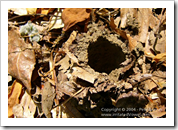
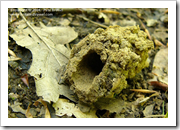
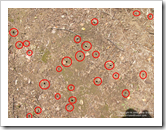
We first started to realize just how many cicadas we were going
to have when we started noticing the holes (figure 1) and
mud-tunnels or chimneys (figure 2) in our yard in late April. The
mud chimneys are created when the cicada pushes mud up out of its
hole after a rain. In our yard, most of the chimneys all broke off
and were lying flat on the ground. However, it was possible to see
them still attached to the hole in many places.
Once the cicadas started to emerge, the number of holes in the
yard became astronomical. It's amazing just how many little nymphs
there were under the ground around our property. They came up in
the dirt, in between paving stones, around foundations,
everywhere.
Nymph Shells
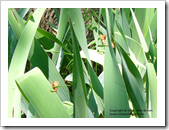
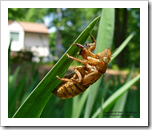
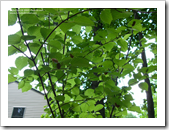
We saw our first solitary cicada shell on the side of our
chimney around May 11, but it wasn't until the day of May 14 that
the cicadas started to really come out on our property. Hundreds of
cicadas literally came out overnight. They seemed to prefer the
areas that were lit up (around our driveway dusk to dawn lights) as
well as the areas that received sun first thing this morning (end
of our driveway).
The cicadas didn't emerge just on trees, they seemed to prefer
any sort of short vertical climb, especially the tall grass-like
leaves of the irises (figures 3 and 4) and short trees such as the
arrowood (Viburnum dentatum) (figure 5)
Inflating their Wings
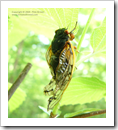
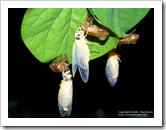
Once the cicadas emerge from their shell, they need to hang
around for a bit and let their wings dry and inflate (figure 6).
This is similar or identical to the process that butterflies go
through to inflate their wings. Previously I thought that the
cicadas would have had their wings completely set by the time they
changed color. However, unless this cicada is simply crippled, it
shows that I was incorrect. This cicada is on the underside of a
arrowood near one of our driveway lights.
The more I see the above photo, the more I think that this
little cicada was just a bit crippled. All the other cicadas I've
seen, that seemed healthy, had already inflated their wings before
they changed color.
You can really see the red eyes and the leg and wing coloration
in figure 6. Note that normal dog-day cicadas are mostly green
while these periodic cicadas are mostly orange/yellow. There is
also a variety with white eyes, and rare ones with brown eyes.
There are additional photos of this process in the cicada log
down towards the bottom of this page.
Adults
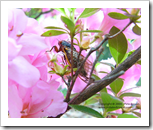
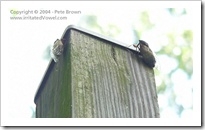
After they dry off, the cicadas just seem to hang around
everywhere. It seems that every bush has a live cicada or its
shell, or some combination of multiples of the two. As of May 14,
very few of these fat little bugs have been seen flying around.
However, I'm sure we'll be picking them out of our hair soon
enough. heh. If only they ate mosquitoes and gnats :-)
The cicada on the azalea (figure 7) really shows the "W" near
the wing tip which is one of the identifying marks of the
periodical cicada. It is still open to question as to whether or
not adult cicadas eat - I've seen texts on both sides of the issue
- so I can't say if he's enjoying some azalea nectar/sap or just
hanging around hoping not to be eaten by one of the numerous birds
in the area.
Predation
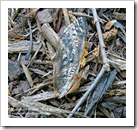
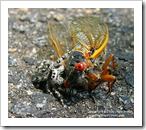
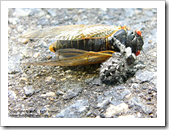
The local birds and spiders have really been having a feast. Not
only do I find wings littered around all the driveway lamps (figure
9) but also half-eaten nymphs as well. When I cleaned out my
Carolina Wren nest box, I found half a snacked-on nymph in with the
nesting material. Obviously junior was having a decent meal ;-)
I've also seen some really strong spiders dragging paralyzed
cicadas across my driveway (figures 10, 11) and up lamp posts. I
didn't realize that the spiders were strong enough to carry such
huge pray around just by their front legs and jaws. Warning,
the spider photos might be a bit gross for folks with sensitive
stomachs.
My Cicada Watching Log - Updates
Friday May 14, 2004
As of May 14 the invasion has only just started. Given that we
live in a very heavily wooded area with very large old-growth oak
and poplar trees, I fully expect that we will be on the high end of
the estimated 1 million per acre. If it rains the weekend of the
15th as is forecast, I expect we'll have quite an emergence.
Saturday May 15, 2004
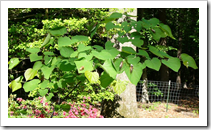
On May 15 we woke to easily ten times as many cicadas as we had
the day before. I know it hasn't really gotten into fully swing,
but I can see the yard is full of holes, and I can hear the cicada
calls from the sunnier parts of the neighborhood. I've heard the
sound describes as someone trying to start a motor or a blender,
but to me it just sounds like a cheesy 1950's "giant bug" movie
sound effect. heh
We saw more half-munched cicadas today, some still alive and
crawling (yuck!). One I saw had only his head and the part of his
body the wings and legs attach to. All the rest of his body had
been taken off, but he was still climbing up the light post! The
birds have hardly been at the feeders with all these easy meals
flying around slowly, or just lying out in plain site.
I already have so many photos of cicadas that it has become a
boring subject. I need to still try and get some of the nymphs
transforming to adults, but I'll need to be out in the night with
all the blood-sucking flies to do that.
Saturday May 15, 2004 - Night
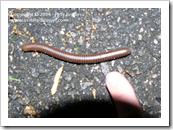
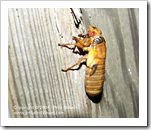
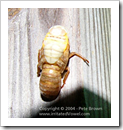
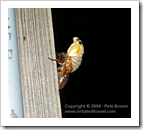
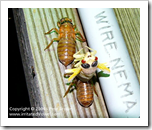
I noticed the day before that all the transformations seem to
take place in the evening or early morning, so around 9:30/10:00 PM
I went outside in the rain to try and take some photos of the
cicadas emerging from their shells. These night shots aren't all
that crisp, but they give you an idea of what is happening.
There were lots of other interesting insects out that night as
well. Not only were there tons of little snow-white moths, but also
a giant millipede that was hauling across my driveway. I had
expected to see the usual half-dozen toads, but there weren't any
in sight. I guess maybe they were all in the mulch eating
cicadas.
Sunday May 16, 2004
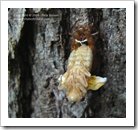
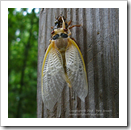
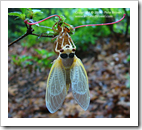
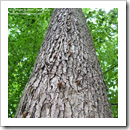
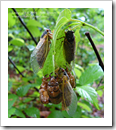
It rained fairly steadily last night through the morning. It was
also pretty hot and humid. Most everything is covered by some
number of cicadas now. Melissa went out in the early morning and
took a bunch of photos, but they don't really do justice to just
how many are already out there hanging on every little branch and
leaf. The noise is much louder today, but still nothing like what
it supposedly gets to.
The Pileated Woodpecker was outside for a bit picking the
cicadas off of the trees. Obviously he's pretty happy about this
easy meal :-)
Monday May 17, 2004 - Popcorn
I actually stayed out into the wee hours of the morning (Tuesday
morning) and watched some cicadas go through the whole process from
crawling up the back wall of my house through emerging fully from
the shell. It really is am amazing process and takes a couple
hours. From memory, this is how it goes (please forgive my lack of
insect body-part terminology):
First the cicada will emerge from the ground and follow an
instinct to crawl up. It doesn't care too much what it crawls up
on, as long as it isn't too sappy. I am not sure what makes some
cicadas crawl up less than a foot and others crawl up 30' or more
to the tree canopy. They aren't the most nimble climbers, and I saw
many fall down several feet onto the ground just to crawl back up
again. The particular cicadas I watched this evening were crawling
up the back of my foundation wall.
Once the cicada has reached what it determines to be the place
where it is going to stop, it stays very still for a while. Once in
a while, it will take a hind leg and massage the back of its hind
end. The one I saw did this a couple times over the course of a
half hour to thirty-five minutes.
At some point, you start noticing the cicada straining. It can't
be mistaken for anything else, really. It would extend its hind end
so that it would curve and touch the wall, and then it would seem
to push. This must take a good amount of energy as it waited
several minutes in between bouts of this.
At some point during the straining, a hairline crack will appear
near the body right behind the head. Once this happens, it moves
pretty quickly from this point on. I originally thought it would be
more of a pop, but it is just a split that happens over time.
The cicada continues to push, widening the crack so that it
looks like popcorn with the white stuff pushing through the crack.
During the pushing, it also uses its hind end to push itself out of
the end of the shell.
Eventually the cicada emerges enough to flop over backwards with
only its hind end still inside the shell. It hangs like this for a
bit, presumably while it re-learns to use its legs.
Once it has control over its legs, it climbs out, hangs onto the
shell from using legs, and begins inflating its wings. The wings
unfurl much like one of those inflatable pools with the membrane in
the middle stretching taught once the frame around the edges (and
throughout, in the case of the cicada) inflates.
Saturday May 22, 2004 - Noisy!
I take back everything I said about it not being very loud.
Today was a very hot and humid day, and the cicada noise was loud
enough that I could hear it over my circular saw. It's amazing how
loud this guys are. Today we also started hearing the "Pharoah"
call for the first time alongside the drone.
For the most part, the emergences have slowed or stopped over
the past week. We had one day in the middle of the week where there
was a huge rush of emerging cicadas, but that was about it.
Monday May 24, 2004 - OSHA Alert
The cicadas were loudest yet yesterday and today. It was also
very hot (in the 90s) and humid both days, something they obviously
like. You couldn't hear the birds or anything out on our back deck
until after the sun started to set. Melissa has taken to wearing
ear protection when she does her gardening. They're not so loud
that they'd damage your hearing, but the constant drone does get
annoying, and it does give you a headache. I could even hear them
through the 6th floor office windows and over the constant blowing
of the AC.
I went into my office in Greenbelt today. Greenbelt, like so
many other urbanized areas, has had many of the tall native trees
replaced by short, stubby, fragile and very invasive pear trees. My
wife could easily give you all the reasons why those foreign
invasive trees are so bad for the environment, and why native
plants are better, so I won't bother with that here. Anyway, the
trees have foliage starting at about shoulder height, so you have
cicadas flying around at that level. I had one smack me in the back
of the head and another perch on my shirt as I went into the office
building. At home they are all a good 30' to 50' up in the air, so
we can look up and see them, but usually don't have any flying
around at head-height. Yet another reason not to remove all the
beautiful tall trees when putting in houses and offices.

On the drive in I found out first hand just how huge a splat a
cicada makes on your windshield at 75mph. It was huge, about the
length and width of the two middle-most fingers on an adult guy,
and is one of those nasty sticky splats (with chunks!) that won't
come off with the washer fluid. No, I couldn't see the eyeballs in
the splat, but I thought that made for a nice little doodle. hehe.
Yuck :-)
We're also starting to see a lot more whole dead cicadas on the
ground. I suspect it will get like short-round said in
Indiana Jones and the Temple of Doom "It's like
walking on fortune cookies!" (or something like that <g>)
:-)
Wednesday May 26, 2004 - Crunchy Frog?
I've been working in DC (corner of 19th and M) on a contract for
the past couple days. For a place that has almost no unpaved land
and only ornamental trees on the sidewalk, the mass of cicadas is
amazing.
The cicadas in that part of DC try to crawl the walls on the
smooth granite buildings but end up falling to the ground and
eventually dying from the impact, being stepped-on, or just from
the struggle. The sidewalk and the nooks and crannies of the
buildings there are just full of
half-living-break-dancing-on-their-back or dead cicadas. It's a
bummer, but also pretty gross. If you stand outside for more than a
few minutes you'll end up with one on you. That's no big deal. More
importantly you need to watch where you walk because the sidewalk
is just covered in smushed cicada adults.
Monday May 31, 2004 - Quiet
The temperature has dropped a lot this week, and there have been
several small rain showers. The two combined have kept the cicadas
down to a low roar.
There is an ever growing pile of half-eaten and otherwise dead
adult cicadas growing in all the corners of the yard (and the
sidewalks in DC). Just the other day I found a smushed one under
the pedal in my car; I believe I picked it up in DC.
There has been no visible tree / shrub damage yet, but I
understand that will happen in June / July.
Saturday June 5, 2004 - First Tree Damage
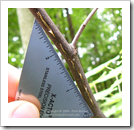
A coworker accidentally stepped on a cicada outside Au Bon Pain
in DC the other day. It sounded like someone stepping on potato
chips - yuck.
It was pouring outside today; we received over 5" of rain.
Nevertheless, Melissa went outside and found the first cicada
damage of the season. The female cicada was kind enough to take a
bit of the top off of the immature (6-7' tall) Redbud tree that
Melissa has planted in the middle of her native plant garden.
We both expected that to happen. At least it was at the top and
not the bottom - so far :-) [Ed: The damage to the tree ended
up being very minimal]
Other than that, the massive amount of rain and the cool
temperatures have together kept things relatively quiet for the
past few days.
Saturday June 12, 2004 - Significant Damage Elsewhere, Very
Little Here (or "Why to keep your Native Trees")
We took a short trip today up to a native plant nursery. One
thing we noticed along the way was all the cicada damage (brown
leaves, dead branches) on trees in disturbed areas and in new
developments. When we got home, we compared it to our property
which has very little cicada damage. Really, other than a couple
small sets of dead leaves on our tall oaks and poplars, and the bit
of top taken off of our red bud, there is nothing.
If I may hypothesize for a moment, I believe that the lack of
damage in our area is based almost entirely on the fact that we
live in a rich natural location with lots of 50'-100' tall trees
and the birds that inhabit them. Besides the blue jays,
woodpeckers, cardinals and song birds on our property, we also have
a good number of squirrels, five-lined skinks, snakes, toads,
frogs, turtles and other cicada-snacking animals around.
People sometimes ask how we get so much wildlife in our area.
The answers are simple. Melissa plants native, animal-friendly
plants, and doesn't use any lawn chemicals or other dangerous
sprays or powders on our property. If you plant native plants, you
don't have to put all that other junk on your property as the
plants have already adapted to the conditions in our location. We
also try to leave dead trees standing as the woodpeckers love to
excavate from them, providing nesting sites for themselves and for
other birds. Melissa provides a bird bath or two, and suet to feed
the birds. When I get a chance, I create birdhouses and nesting
boxes.
So did netting and sprays and other expensive and damaging
remedies protect us from the "cicada devastation"? No. It was the
fact that we had lots of native trees and plants and the wildlife
they harbor. While I don't want to sound too preachy about this, I
think this goes to show just another reason why we should leave as
many native trees (oaks, poplar, maples; not the invasive pears,
Norway maples, trees-of-heaven and other junk trees) as possible on
our collective property.
We had no shortage of cicadas; we easily had numbers of them on
the high-end of the scale. They just helped to serve a natural
purpose and provided a rich bounty for the wildlife in our area.
Please think about this the next time you shower your lawn with
chemicals, or the next time you see a great wooded area being
clear-cut for a new development. While it might take a little more
effort to get the heavy equipment in to level the area, you can
have a wooded area and development with very little sacrifice on
either side.
About Mid June (15-20), the Cicadas pretty much disappeared.
There endeth the invasion.
All photos on this page were taken with a Panasonic
Lumix FZ-10 on our property in Gambrills, MD.
Additional References
Cicadas
A
great page on the Periodical Cicada
Another great page including recordings of the sound they
make
Native Trees and Plants
Chesapeake Native
Plant Nursery (Where Melissa used to volunteer and now
works)
Cicada Desktop Wallpaper / Backgrounds
For desktop backgrounds / wallpaper of Cicadas and other insects I have
photographed, click here
